|
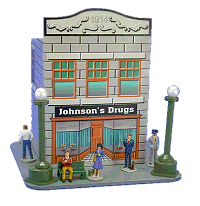 Note from Editor: This project is another in our Tribute to Tinplate(tm)" series, a tribute to the tinplate villages and trains that surrounded so many Christmas trees in the early 1900s. Note from Editor: This project is another in our Tribute to Tinplate(tm)" series, a tribute to the tinplate villages and trains that surrounded so many Christmas trees in the early 1900s.
Like the  Lewis Park Station project, we are combining Paul's lithograph-inspired downloadable graphics with Howard's construction tips and plans. Lewis Park Station project, we are combining Paul's lithograph-inspired downloadable graphics with Howard's construction tips and plans.
For this project, we chose a series of candy containers that were made in the early-to-mid 1900s by West Brothers. Each container included a glass full of candy that you could see through the house's "windows." A photo of the candy tin that inspired the drug store project is at the left. 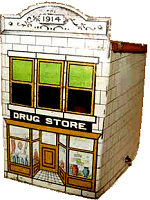 To create the lithographic-style graphics, I worked from photographs of the originals as much as possible to reproduce the architectural details and the fake 3-D entrances. However, I increased the size of the buildings, to look right with our trains and villages. I also added extra details to keep the buildings from looking too plain at the larger sizes. For the store window contents, I had to get even more creative, combining original graphics with photographs of antique store windows. To create the lithographic-style graphics, I worked from photographs of the originals as much as possible to reproduce the architectural details and the fake 3-D entrances. However, I increased the size of the buildings, to look right with our trains and villages. I also added extra details to keep the buildings from looking too plain at the larger sizes. For the store window contents, I had to get even more creative, combining original graphics with photographs of antique store windows.
Creating multiple "different" buildings by changing the graphics on the same basic structure was a favorite money-saving device of several tinplate toy manufacturers. The three buildings we have so far are inspired by specific tins for which we found photos. Of course, once I designed one of these, I just had to design a couple more. In the meantime, Howard kept trying out different ways to use the designs and sending me his feedback.
The main reason we don't have four or five structures in this article is that we ran out of time. I have plans for at least two more storefronts that I hope to get to eventually. If you sign up for our Trains-N-Towns(tm) newsletter, we'll let you now when we create and upload more storefronts or other projects you might find helpful.
Building TinPlate-Syle Store Fronts
After Paul and I started creating our first Tribute to Tinplate(tm)" buildings, we both started combing the Internet for photographs of worthwhile projects. The problem isn't lack of examples; it's that there are so many to chose from. After the Vine-Covered Cottage project, which turned out to be fairly complicated, Paul wanted to pick one that would be different than any we had done so far, simpler to build, and reusable just by changing the graphics. So the West Brothers' tin storefronts seemed like a good next project. That didn't keep me from giving him plenty of feedback, though. Still, when Paul sent the final graphic files and I printed them on a good color laser, I couldn't help getting excited about this project, and about how it would look with my tiny but growing O gauge Marx railroad.
What You Will Need
- Clean solid cardboard, such as from cereal boxes or posterboard. I especially like to use a thick cardboard, like the back of a writing tablet.
- Thick, clean cardboard or foam core for the base and roof
- Corrogated cardboard or foam core board for the foundation
- A sharp mat knife or Xacto knife
- Elmer's white Glue-All. A glue stick would also come in handy.
- Several sheets of acid-free white bond paper
- Light card stock for printing the graphics (optional)
- Gray paint for the base
- Acrylic paint or markers for the exposed edges of the cardboard.
- Access to the Internet and a color printer.
- Clear glossy acrylic finish to help give a metallic appearance and protect the graphics when you are finished.
For a more comprehensive list of tools and supplies that come in handy on any cardboard house project, please refer to our article What You Need to Build Glitterhouses.
A Note about Scale
Although my Marx trains run on O gauge tracks, they are closer to S scale (1:64), the scale of S gauge American Flyer trains, and many collectible village houses. So I chose that scale to build these projects. If you're running larger equipment (like post-war Lionel, for example), you might consider the O scale version.
What if You Need Something Bigger? - If you're running Large Scale (garden trains) or the old-fashioned Standard Gauge tinplate trains, you will need to contact Paul for the 1:37 version, the largest that these buildings can be printed out on most printers. Or you might be able to get a copy center to print the S-scale or O scale graphics at 2X on a large format printer (for 1:32 or 1:24 respectively) - the resolution of the graphics should be high enough to support that. But those files are just too big to host permanently unless folks start donating more toward Paul's Hard Disk
Space fund. :-)
If you want to be certain your project will look right with your existing equipment, consider doing a "mockup" first. Choose the scale you feel mostly likely to prefer, and print out a copy of Paul's graphics for that scale in black and white (saving your color cartridges). Then cut and fold the printout to make a mockup you can set next to your trains and other accessories before you begin the final structure.
Print the Patterns
This project has a structure pattern that you will need to cut out and transfer to cardboard, as well as graphic sheets that you will use to finish the building's appearance. Again, doing a mock-up to make certain the finished structure will look right with your existing equipment is very important.
Note: For this project, we have provided the patterns only in S scale, the scale we used for this project. Go ahead and print out the patterns, though, as they include the measurements for O scale. If you need additional measurements for an O-scale project, you can get them from Paul's graphics. Be sure to measure between the "fold lines" when you're measuring horizontally, though.
You may print the structure pattern on any sort of paper, since you're simply using this to transfer the plan to your cardboard medium. However the "lithograph" graphic should be printed on acid-free heavy paper or card stock. Note that Plans 1a and 1b are meant to be spliced together before you transfer the pattern to the cardboard.
For Optimum Printing - For the lithographic "wraps," we have used professional "vector" graphics when possible, to make certain that you get the highest resolution graphic, whatever scale you use. In most cases, you can get the best result by right-clicking on the name of the graphic you need, then saving the pdf file to your hard drive. (That way if you accidentally print them at the wrong size, which is very easy to do on some printers, you don't have to download them again.)
Then navigate to the folder where you saved the files and click on the file name. Adobe Acrobat Reader should open up. Make certain that the graphic or plan file is set to print at 100% ("scale to fit" or "fit to page" should not be checked).
Structure Patterns
Store Fronts
Store Sides and Backs
Each store front will also require one back, both sides, and one "extra" printout.
Tar Paper/Flat Roof
These patterns are from another feature, so you'll have to trim them to size after you download them. Though I like the staggered pattern best, I did one of each of these, just for variety. Which one or ones you use is entirely up to you. It was common on structures like this to change up even the insignificant patterns when redrawing the graphics, so don't worry too much about consistency.
If you can't get the graphics to work the way you need them to, contact
Paul and ask him for help - that's his department. :-)
A note about Copyright - However you use these plans and graphics for your personal use, please keep in mind that the lithograph graphics are copyright by Paul Race and are not to be copied, re-used, republished, or repurposed without prior permission and appropriate credit. Commercial use without prior permission is illegal and expressly forbidden. Paul likes making resources like this available to hobbyists, but they are expensive and time-consuming to produce and publish, and it's frustrating to see other folks profiteering off his hard work. In other words, if you like having this kind of resource available and you'd like to see more, please respect the creators' rights.
Building a "Mockup"
You will save time and sanity in the long run if you print the graphics in low-res B&W first to make certain that the are the right size for the plans you have printed out and that they are the right size to go with the rest of your equipment.
First, make certain that the plans you have printed are the same size as the graphics you have printed. Sadly, it is very easy to download all the right graphics, then click the wrong button (such as "fit to page") when you go to print. Worse yet, a few printer drivers make all of those decisions for you unless you click on the "advanced" button or some such.
As silly as this step may sound, use cheap paper to print the plans, then print the graphics in draft mode in black and white (to save toner cartridges). You can try holding both sheets up to the light, but sometimes it's hard to get a complete "picture." Remember, when you score and fold the frame pieces, the actual structure should be a bit wider in each direction than the pieces you cut out, because you need to compensate for the thickness of the cardboard you are using. Paul's wall graphics extend the wall pattern beyond the fold lines to compensate for any minor differences, but don't count on that compensating for any major discrepancies.
The best way to be sure you have plans in the same scale as your graphics is to fold the graphics along the fold lines, then cut them out and hold them up to the frame pieces. Again, the frame should be slightly smaller, especially horizontally. If it isn't, you should adjust the size of the frame when you transfer the plans to the card stock. Mismatched sizes between graphic and plans is a problem that is much easier to head off beforehand than it is to solve once you've cut out the building frame.
Then while you have the cheap printout cut out anyway, tape or glue it together and set it alongside the stuff you already have to be sure it's the size you want. If not, select a different scale and try again.
[Ed note: Howard actually put together two mockups, one based on the first set of graphics I sent him and another using a graphic file supplied by David Farquhar, based on photographs of an original West Brothers structure. Howard wrote notes all over the B&W one and sent it to me with a list of suggestions. However, sending me your projects with a list of suggestions probably won't work for you as well as it does for Howard. To see David's website about his tinplate train hobby, click here:-) - Paul]
Cutting and Scoring the Frame Pieces
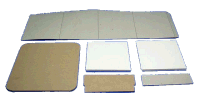 Once you are confident your frame pieces are the right size, use a Xacto-type knife and a straight edge to carefully score every place where a fold is indicated. Then cut the pieces out and fold them into a square. Once you are confident your frame pieces are the right size, use a Xacto-type knife and a straight edge to carefully score every place where a fold is indicated. Then cut the pieces out and fold them into a square.
Now it's time to temporarily fold the B&W graphics around the walls as a "sanity" check. If it helps you to actually put one together this way, go for it. Engineers have a saying "build one to throw away, you will anyhow."
 The photo to the right shows the four walls glued together. The photo to the right shows the four walls glued together.
Building the Base
It was Paul's idea for the base to represent a sidewalk/curb around the building. It will eventually give you a very nice place to set figures, fire hydrants, lamp posts, and the like. To provide room for such accessories, it extends one inch out to each side and two inches out front.
I made the base by laminating two pieces of the thin corrugated cardboard from Express Mail packages. You could laminate "matte" cardboard as well.
The foundation should fit loosely inside the four sides of the building once it is assembled. Eventually, it will give you more surface for gluing the building down to the base reliably. That said, you don't want to glue the foundation to anything until the building is complete and you have checked the fit one last time.
To finish the base, I used gray paint to represent sidewalk. Because I had used corrugated cardboard, I was careful to dab paint into the edges to fill in the gaps. I probably could have used vinyl spackling do accomplish the same thing. If you wish, you can draw thin black lines on the base in a grid pattern to represent the sidewalk pattern; I've done that on other structures but I haven't done it on these yet.
Building the Crest and Support
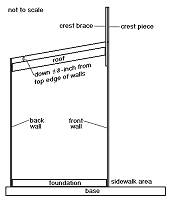 Technically, I could have made each storefront from one big piece of cardboard, including room for the "crest." As it turned out, it was easier for me to build the crest separately and fasten it on to the building front after I had the four walls glued together. I also added an extra layer of support to the crest, since it would be sticking out and more prone to "bumping." Plan 3 shows a side view of how I layered these pieces. Technically, I could have made each storefront from one big piece of cardboard, including room for the "crest." As it turned out, it was easier for me to build the crest separately and fasten it on to the building front after I had the four walls glued together. I also added an extra layer of support to the crest, since it would be sticking out and more prone to "bumping." Plan 3 shows a side view of how I layered these pieces.
By making three of these at the same time, I could work on one while the other one was drying, and so on.  In the photo to the left, the buildings are set on the foundation and base to check the fit and general appearance, and to make certain they stay square while the glue is drying. However, the buildings are not fastened down until after the graphic wraps are applied and the bases are painted. In the photo to the left, the buildings are set on the foundation and base to check the fit and general appearance, and to make certain they stay square while the glue is drying. However, the buildings are not fastened down until after the graphic wraps are applied and the bases are painted.
Let the building frames dry at least overnight before you start applying the graphics - the last thing you need is a joint popping or the frame getting wobbly while you're trying to be precise with the graphic.
Applying the Graphics
Then I carefully applied the graphic wraps to one wall at a time.
I started on the sides, then did the back and front. I could have started with the backs just as easily, but the front definitely has to come last.
At my insistence, each of Paul's graphics includes a little bit of extra material at the edges to take up any "slack" in case your measurements are an eighth of an inch off or something. Before you cut off the fold lines, hold the wrap up to the wall it is going onto and see how close the fold lines are to the actual corners. If they're close, fold the first wrap (a back or side) along one fold line, then hold it against the wall you will be using it on. Then, if it is necessary, you can adjust the other fold. When you're certain your fold lines are where they need to be, crease them sharply and cut the white parts off of the graphic.
Spread a thin layer of glue over the entire wall to be glued, and along the edges where the extra bits will wrap around the corner. Then fasten the graphic down carefully.
Consider using clothespins or the like to make certain the wrap doesn't shift during the drying process.
Once the first "wall" has dried, you add the next wall, except that one of your "fold lines" on the next wall should actually be a "cut line" if your graphic pages are fitting where they need to be. Remember you may also be trying to align mortar lines at the same time, so take your time.
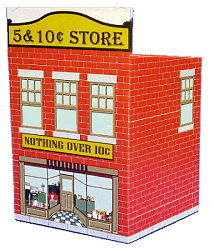 On the last wall (probably the front), both "fold lines" should be cut lines, but make certain both cuts align perfectly with the corners of the building. On the last wall (probably the front), both "fold lines" should be cut lines, but make certain both cuts align perfectly with the corners of the building.
Because I didn't cut the crest's shape out, the building's crest looks a little funny at first. I could have cut it out ahead of time, I suppose, but then I'd have an extra variable while trying to align the graphic for the store front with the left and right edge. Or worse yet, I'd discover that I had cut the crest shape wrong and have to start a building all over again.
Trimming the Crest
When the glue for the front has dried completely (meaning overnight at least), use a very sharp Xacto-style knife to trim the crest to match the shape of the graphic. Don't rush this job or try to cut all the way through both layers of cardboard on the first pass.
Instead, make many light passes.
 I tried a couple different ways to finish the back of the crest and the inside edges of the walls, but nothing quite worked. Finally I printed some extra bricks and sliced and diced them to go on the back of the crest and on the inside walls about a half-inch down all the way around. Paul has since provided a page of "extra bricks" to use for this purpose and anything else you want to use them for. I tried a couple different ways to finish the back of the crest and the inside edges of the walls, but nothing quite worked. Finally I printed some extra bricks and sliced and diced them to go on the back of the crest and on the inside walls about a half-inch down all the way around. Paul has since provided a page of "extra bricks" to use for this purpose and anything else you want to use them for.
Applying the Roof
Once you have the structure glued together and all graphics applied, cut out a piece of corrugated cardboard or foam core for the roof. It should fit just inside the walls as shown in the photo above right. Choose and apply a roofing pattern, and when it is completely dry, fasten it in place. I fastened mine about an 1/8" down from the side and back walls. I actually applied the glue from inside the building, then brushed it into the seams where the roof fit the walls.
Touch Up the Cut Lines
When all the graphics are applied, take a marker or fine-tipped brush and touch up the edges of the cut graphic media with a color that is compatible with the bricks or stones.
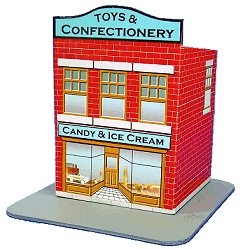 Assemble the Structure Assemble the Structure
Once you have tested all of the fits, it's time to glue your structure(s) together. Double-check the fit of the foundation inside each building, then glue it onto the base. I'd give the foundation a few minutes to set before gluing the building down on top of it. Again, the hurry-up-and-wait aspect of this stage of the project is reduced if you are working on two or three buildings at once.
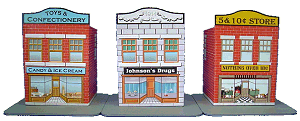
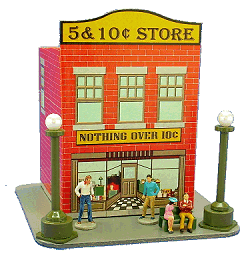 Finish Finish
Wait until the graphics, paint, and glue are thoroughly dry (at least overnight, if not 48 hours), then spray the structure(s) with several light coats of a clear glossy indoor/outdoor acrylic finish. This protects the surfaces from moisture and dust and also helps reduce fading. In addition, it makes the lithography pattern "pop." Do not such a heavy coat in one pass that you cause any streaks, runs, or drips, though, or you'll have to start over.
Of course the structures will really come to life when you add accessories and put them into some sort of setting, even a simple one.
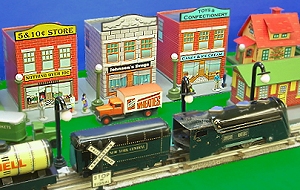
Conclusion
If you like this project, stay in touch - more are on the way. In the meantime, you might like to take a look at the following projects.
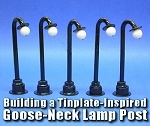 Building Tinplate-Inspired Goose-Neck Lamp Posts Add even more vintage variety to your tinplate-inspired communities, for less than $1 each worth of materials. Free downloadable instructions are provided. Building Tinplate-Inspired Goose-Neck Lamp Posts Add even more vintage variety to your tinplate-inspired communities, for less than $1 each worth of materials. Free downloadable instructions are provided.
- Building a Vintage "Lithographed" Station"
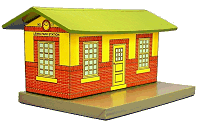 - the first article in our "Tribute to Tinplate" series, based on a prewar American Flyer standard-gauge station. Includes free, downloadable graphics, plans, and instructions for modeling in O/S and Large Scale/Standard Gauge. - the first article in our "Tribute to Tinplate" series, based on a prewar American Flyer standard-gauge station. Includes free, downloadable graphics, plans, and instructions for modeling in O/S and Large Scale/Standard Gauge.
- Building a Vintage Tin-Style Cottage
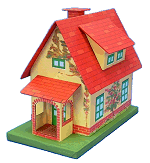 - This project is inspired by a popular pre-war tinplate house that was made to go with standard gauge trains, like the early 1900s-era Ives and Lionel. Paul Race's commercial-quality graphics, as well as Howard Lamey's plans and assembly details are all free, to give your railroad a vintage tinplate look with a few cents' worth of materials. Many options are available, and most graphics and plans can be downloaded directly from the article. - This project is inspired by a popular pre-war tinplate house that was made to go with standard gauge trains, like the early 1900s-era Ives and Lionel. Paul Race's commercial-quality graphics, as well as Howard Lamey's plans and assembly details are all free, to give your railroad a vintage tinplate look with a few cents' worth of materials. Many options are available, and most graphics and plans can be downloaded directly from the article.
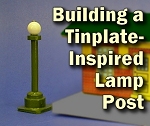 New
Feature - Building a Tinplate-Inspired Lamp Post The ideal accessory for the Lewis Park Station, or any station or city hall on your railroad or holiday village. No, they don't actually light, but they are cheap and easy to build and add a great deal of vintage interest to any setting. Free downloadable plans are available in several scales. New
Feature - Building a Tinplate-Inspired Lamp Post The ideal accessory for the Lewis Park Station, or any station or city hall on your railroad or holiday village. No, they don't actually light, but they are cheap and easy to build and add a great deal of vintage interest to any setting. Free downloadable plans are available in several scales.
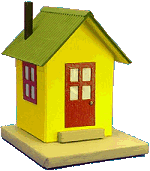 New
Feature - Building a Tinplate-Inspired Watchman's Shanty Back in the day before automated crossings, these were common sites alongside busy rail crossings. Howard's exclusive design pays tribute to a series of tinplate structures that go back a hundred years and include three different scales. His free plans and instructions will help you dress up any indoor railroad or holiday village. New
Feature - Building a Tinplate-Inspired Watchman's Shanty Back in the day before automated crossings, these were common sites alongside busy rail crossings. Howard's exclusive design pays tribute to a series of tinplate structures that go back a hundred years and include three different scales. His free plans and instructions will help you dress up any indoor railroad or holiday village.
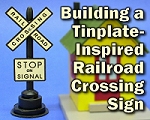 New
Feature - Building a Tinplate-Inspired Railroad Crossing Sign This is the ideal accessory for the Watchman's Shanty project. Based on a series of products that are now available only as expensive collector's items, this easy and almost-free project will add texture, interest, and period to any model railroad or holiday village. New
Feature - Building a Tinplate-Inspired Railroad Crossing Sign This is the ideal accessory for the Watchman's Shanty project. Based on a series of products that are now available only as expensive collector's items, this easy and almost-free project will add texture, interest, and period to any model railroad or holiday village.
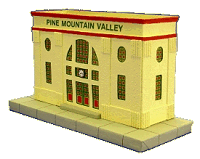 Building the Union Station - This original project by designer Howard Lamey is inspired by two traditions - the cardboard Christmas houses that were popular in US homes between 1928 and 1965 and the Lionel station that was popular for most of the 20th century. Building the Union Station - This original project by designer Howard Lamey is inspired by two traditions - the cardboard Christmas houses that were popular in US homes between 1928 and 1965 and the Lionel station that was popular for most of the 20th century.
- Easy Street Scene - This new
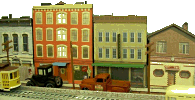 building project uses downloadable building graphics and a little cardboard or foam board to build up a convincing downtown scene that is only a few inches deep - perfect for shelf layouts, tight spots, and dioramas. We also provide links to high-resolution graphics that will work for any scale. building project uses downloadable building graphics and a little cardboard or foam board to build up a convincing downtown scene that is only a few inches deep - perfect for shelf layouts, tight spots, and dioramas. We also provide links to high-resolution graphics that will work for any scale.

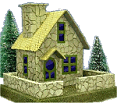 Build a Vintage-Style Cardboard Stone Cottage - This building project is made like the vintage cardboard houses folks used to set around their Christmas tree in the early 1900s (before glitterhouses became common), but its design was inspired by a building that shows up on the "Isle of Sodor." The building uses free downloadable graphic paper to put a realistic stone veneer on an old-world cottage and fence. It works with Christmas villages, or with a little customization, would dress up any indoor railroad. A "brick cottage" option is also shown.
Build a Vintage-Style Cardboard Stone Cottage - This building project is made like the vintage cardboard houses folks used to set around their Christmas tree in the early 1900s (before glitterhouses became common), but its design was inspired by a building that shows up on the "Isle of Sodor." The building uses free downloadable graphic paper to put a realistic stone veneer on an old-world cottage and fence. It works with Christmas villages, or with a little customization, would dress up any indoor railroad. A "brick cottage" option is also shown.
 Log Cabin Building Flat - This "building flat" uses downloadable graphics and foam board or cardboard to dress up a narrow corner of your railroad or village. The techniques in this project can be used for almost any kind of building you want to represent in a tiny space. December, 2007 Log Cabin Building Flat - This "building flat" uses downloadable graphics and foam board or cardboard to dress up a narrow corner of your railroad or village. The techniques in this project can be used for almost any kind of building you want to represent in a tiny space. December, 2007
- Build a Vintage-Style Barn and Silo - This
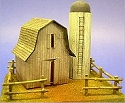 building project uses downloadable graphics to put realistic shingles and siding on an old barn and silo. Like the stone cottage above, it works with Christmas villages, or with a few changes, it would dress up an indoor railroad. building project uses downloadable graphics to put realistic shingles and siding on an old barn and silo. Like the stone cottage above, it works with Christmas villages, or with a few changes, it would dress up an indoor railroad.
Other Articles about cardboard houses include:
|
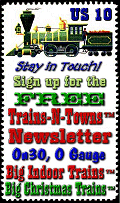

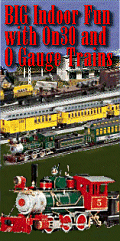



|



 Lewis Park Station
Lewis Park Station
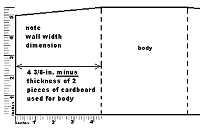
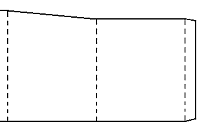

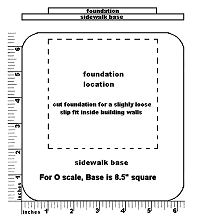
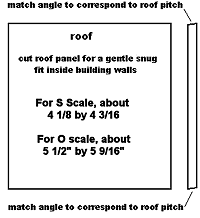

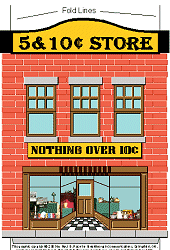
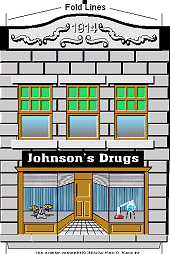
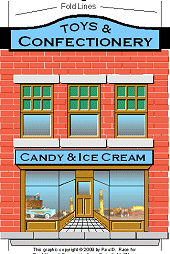
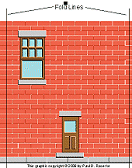

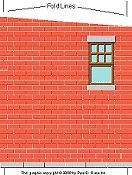
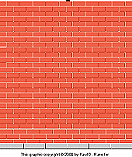

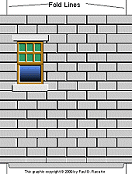
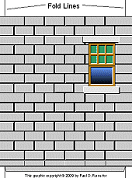
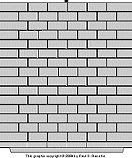



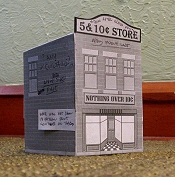
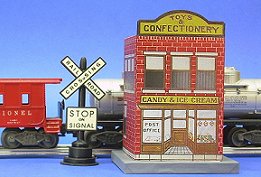









 Building Tinplate-Inspired Goose-Neck Lamp Posts
Building Tinplate-Inspired Goose-Neck Lamp Posts

 New
Feature - Building a Tinplate-Inspired Lamp Post
New
Feature - Building a Tinplate-Inspired Lamp Post New
Feature - Building a Tinplate-Inspired Watchman's Shanty
New
Feature - Building a Tinplate-Inspired Watchman's Shanty New
Feature - Building a Tinplate-Inspired Railroad Crossing Sign
New
Feature - Building a Tinplate-Inspired Railroad Crossing Sign Building the Union Station
Building the Union Station 











